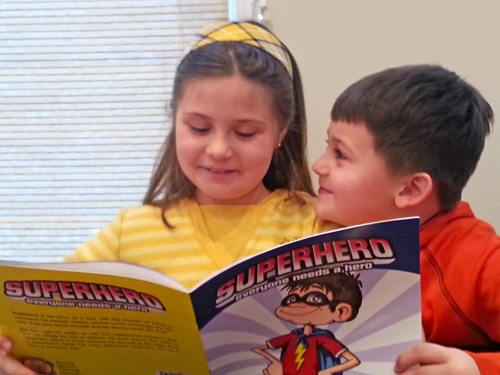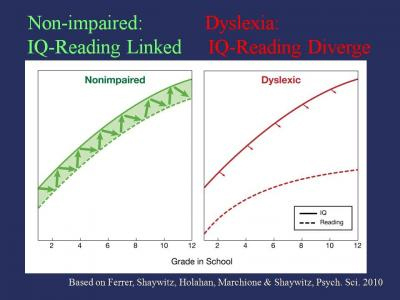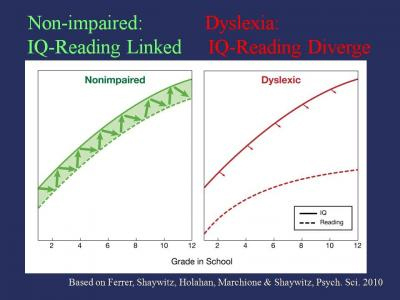Don M. Winn's Blog, page 24
January 8, 2015
How Heroes of Self-Reference Can Help Struggling and Dyslexic Readers
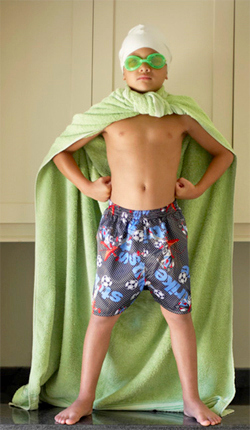 The term “hero of self-reference” may be an unfamiliar one, but it’s important to know and understand. Why? Because in children���s books, such heroes can be pivotal in helping the dyslexic or struggling reader see themselves in new ways, with new possibilities and potential.
The term “hero of self-reference” may be an unfamiliar one, but it’s important to know and understand. Why? Because in children���s books, such heroes can be pivotal in helping the dyslexic or struggling reader see themselves in new ways, with new possibilities and potential.
What’s the basis of this understanding? To get to its root, we have to take a trip into systems theory. Don’t stop reading, this is simply a technical term for something we can all relate to. This is worth your time, I promise. Systems theory has at its core the idea of self-regulating systems, in other words, the human ability to self-correct based on feedback. Niklas Luhmann was a key thinker in systems theory, and he observed that hero narratives have the power to change our conscious belief systems���especially our beliefs about ourselves and what we are capable of doing. (La Cour, Anders, and Andreas Philippopoulos-Mihalopoulos. Luhmann Observed: Radical Theoretical Encounters. Palgrave Macmillan, 2013.)
When the hero of a story has characteristics, feelings, or struggles like our own, we identify with him or her. We recognize that we are not alone in our experiences and that there are others out there like us. Once that reader/hero bond is established and we see our hero accomplishing things we never dreamed we could, we can begin to be curious and hopeful about our own potential. According to the reference work mentioned above, ���through exceeding expectable achievements,” the hero is ���able to fulfill his socializing-educational function.��� The reference concludes, “The hero can do things differently than they have previously been done; he can do them better; and he can do both provided he finds some felicitous balance between originality and exceptional skill.”
Dyslexic kids have very few heroes of self-reference. As struggling readers, they belong to a group that has been judged harshly both by themselves and by traditional educational systems as unmotivated, stupid, slow, or lazy. However, nothing could be more untrue. Many dyslexic children grow up to be successful adults who bring their own unique and original methods of getting things done to whatever their particular field may be.
As struggling readers, they belong to a group that has been judged harshly both by themselves and by traditional educational systems as unmotivated, stupid, slow, or lazy. However, nothing could be more untrue. Many dyslexic children grow up to be successful adults who bring their own unique and original methods of getting things done to whatever their particular field may be.
Sadly, doing things differently is rarely recognized as a strength in current educational norms. Therefore, “expectable achievements” for dyslexic students are often low. This is something that can be changed in society by cultivating awareness. It can be changed for individual students by helping them find heroes who have weaknesses and strengths like themselves. The often unrecognized exceptional skills of dyslexia can include dogged determination, an ability to see the big picture, and a talent for thinking outside the box.
With that in mind, I���d like to introduce Reggie Stork (below, left), one of the main characters in my new novel for middle grade readers, The Lost Castle Treasure. Reggie represents all of us dyslexics. He is our hero of self-reference. He struggles with reading and writing, but through his determination and different ways of seeing things, he plays a crucial role in finding the missing treasure and solving a few mysteries along the way.
Although learning in the Middle Ages was very different than it is today, formal learning still involved books, reading, and writing���in other words, dyslexic kryptonite.
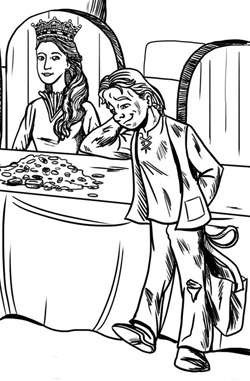 Reggie goes through all the same feelings of unworthiness and uses the same avoidance tactics dyslexic students do today. He tries to get by on his wits by interpreting stories via available illustrations, avoiding writing whenever possible, absenteeism���you name it. Dyslexic students and struggling readers today will identify with Reggie and his vexing relationship to books, writing, tutors, and the shame of his secret. They will also be encouraged to develop new beliefs about themselves through seeing Reggie discover his strengths. As Reggie learns to view himself as a valuable part of a team of remarkable young boys, young readers can also learn to see their own value and their immense potential for a full, meaningful, and satisfying life beyond their dreams.
Reggie goes through all the same feelings of unworthiness and uses the same avoidance tactics dyslexic students do today. He tries to get by on his wits by interpreting stories via available illustrations, avoiding writing whenever possible, absenteeism���you name it. Dyslexic students and struggling readers today will identify with Reggie and his vexing relationship to books, writing, tutors, and the shame of his secret. They will also be encouraged to develop new beliefs about themselves through seeing Reggie discover his strengths. As Reggie learns to view himself as a valuable part of a team of remarkable young boys, young readers can also learn to see their own value and their immense potential for a full, meaningful, and satisfying life beyond their dreams.

January 1, 2015
Lessons Children Learn From Our Example

Me and my dad.
As one year ends and another begins, many of us might find ourselves in a reflective frame of mind. The human brain seems to be hardwired with thoughts of endings and fresh starts during this season of shorter daylight hours and chilly weather. For myself, vivid memories of the grounding lessons I received in childhood and my parents��� examples come to my mind. Teachings received from our parents in our earliest years can be what we draw on the most as we consider what to do next with our life. I frequently think of my dad during these times, but I rarely focus on the things he told me. Rather, it’s the things I learned from his example.
I’d like to share the following��previous blog post again as a reminder that your time and your example are two things your child will never forget.
Your Time And Your Example���Two Things Your Child Will Never Forget
Originally posted on February 21, 2012 by Don M. Winn
I have been thinking about my father lately. When I remember my childhood now, I think more about the things I took for granted at the time than about all my childhood adventures. For example, I never had any doubts that my father loved me; it was just a given. And this, of course, is how it should be for any child. I know I received plenty of instruction and discipline as a child, but I hardly remember any of it now. Instead, it is my father���s example that stays with me to this day. I learned so many things simply by watching him every day���from life lessons to little things, like tying a tie. I know for a fact that no one ever taught me how to tie a tie. But I know how to do it today because I watched my father tie his tie every morning before he went off to work.
My father was already nearly fifty when I was born. He grew up during the Great Depression and learned early in life the importance of hard work and of doing his best. He tried to instill the same values in me. Of course at the time, I didn���t appreciate the significance of my dad���s wisdom, but as I became an adult, my memories of him became all the more precious. I say memories, because my father passed away while I was still young. And though I didn���t have the opportunity to know my father from an adult perspective, I can���t imagine what my life would be like today without having had his love, discipline, and example during my early years, an example that I still draw on today.
I spent most of my time with Dad���when I wasn���t playing of course. I loved to go with him on his sales calls and errands���I liked the lumberyard best. When he worked on his many home-improvement projects, I was always underfoot wanting to help, and graciously, he would let me, although it usually made more work for him. Even when he did paperwork, I was again underfoot with my own make-believe desk and a handful of very valuable junk mail, which I pulled out of the trash, pretending to be a businessman. I watched him when he shaved, shined his shoes, put on a tie, and I lobbed more questions his way than even Jimmy Connors could return. And last but not least, I was always there when he raided the ice box for a snack���homemade ice-cream was my favorite.
Not only did I learn by my father���s example, I also learned that it���s not just brief snippets of ���quality time��� that children need, but rather just plain old time���and lots of it. I know my father was a busy man. He had lots to do and I���m sure he dealt with lots of stressful problems in his life, as all adults do. But to this day I am impressed with the graciousness with which he included me in his many chores and activities. I never felt unwanted or like I was in the way. I always felt like it was just great to be with my dad and that he felt the same way about me as I was ���helping��� him.
What lessons do your children learn from your example? Are you gracious and generous with your time, allowing youngsters to copy your activities and learning as they go? If so, then you are laying a foundation for your child that will last a lifetime.

December 31, 2014
Interview with Conservationist and Author Jannifer Powelson
Last week, I introduced you to Jannifer Powelson, a conservationist and author from the Midwest, who has written a series of children���s books about nature and conservation. There’s a real need for all of us today to make sure we���re reconnecting with the natural world. In our fast-paced modern life, many of us live in urban areas and think of nature as something we have to drive somewhere to see.
Jan works at a conservation district, where she interacts with children and educates them about the natural world. In addition, she���s the author of the Rachel and Sammy books, where she gives kids a closer look at aspects of nature that some may not see otherwise. I was interested in Jan���s approach to nature and writing for children, so she kindly agreed to answer a few questions for me. I hope you enjoy her responses.
Don: How did you develop an interest in nature and conservancy?
Jan: I grew up on a farm and worked and played outdoors almost every day. As a farmer, my dad instilled the importance of conserving soil and other natural resources in us. Though it was hard to get away from a farm where we not only raised crops but also livestock, we always managed to take a summer vacation. We normally visited state and national parks, where we could enjoy scenery that was so much more breathtaking than the more subtle beauty of rural Illinois. I later decided to study biology in college, where my interest in nature grew even more as I took as many ecology, botany, and zoology classes as I could.
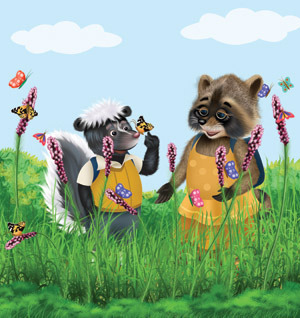 Don: I like the juxtaposition of the artistic interpretations of the plants with actual photographs in your books. Do you envision your books being used as field guides to help readers identify plants?
Don: I like the juxtaposition of the artistic interpretations of the plants with actual photographs in your books. Do you envision your books being used as field guides to help readers identify plants?
Jan: Yes, I see these books, especially Rachel and Sammy Visit the Prairie and Rachel and Sammy Visit the Forest ��� A Guide to Spring Woodland Wildflowers as junior field guides. My hope is that parents, grandparents, etc. will take children outdoors and use the books to help children learn, or at least recognize, the native plants common to the area. These books also teach readers more general plant information, which is relevant no matter where you live.
Don: Your book Rachel and Sammy Learn to Conserve offers many practical suggestions for kids themselves to implement. Turning off the water while brushing teeth, planting native rather than exotic plants, catching rainwater, and awareness of soil conservation are just a few of the things you bring to your readers’ attention. How do you feel kids benefit by learning about conservation?
Jan: When children learn about the importance of natural resources and conservation at an early age, they will hopefully carry that knowledge with them as they mature and later make wise decisions based on their early learning. Showing children how beautiful nature can be also makes them more interested in protecting and conserving it. Even if they don���t remember the name of a particular plant, they will understand the importance of native plants to an area, and hopefully appreciate them more.
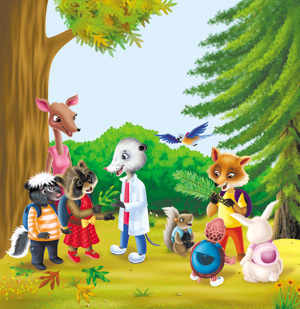 Don: In the dedication, you mention that your grandparents taught you to save and reuse. What can parents do to foster awareness of and respect for our earth’s natural resources?
Don: In the dedication, you mention that your grandparents taught you to save and reuse. What can parents do to foster awareness of and respect for our earth’s natural resources?
Jan: Parents can encourage their children to play outdoors, whether it is running around doing physical activity or even taking their books and electronic devices outdoors. They can take their children to parks, natural areas, and nature centers to help children learn to appreciate nature. The more often children are exposed to nature, the more likely they will be to appreciate it and want to continue experiencing it. Families can practice conservation activities around the home. Recycling and teaching water and energy conservation are simple and effective hands-on ways to teach children to conserve.
Don: When I was a kid, all I knew about trees was that they were fun to climb. In Rachel and Sammy Learn About Trees you offer understandable explanations of photosynthesis, the life cycle of an oak, as well as the structural parts of trees and their functions. In your work with kids at the conservation district, what do kids most appreciate learning about trees?
Jan: Much of the educational storyline of Rachel and Sammy Learn About Trees comes from third grade Arbor Day programs I���ve done throughout the years. It amazes me how much children at this age already know about trees, whether it���s the numerous products that are derived from trees or the fact that trees produce oxygen as a byproduct of photosynthesis and pull carbon dioxide from the air to use as an ingredient to produce their own food.
Don: How did you come up with your characters Rachel and Sammy?
Jan: During my graduate school days, I conducted wildlife research on raccoons, which is how Rachel Raccoon was derived. I also encountered several other mammals, including skunks. I even thought it would be interesting to study skunks, until an overly excited skunk decided to spray me directly in the face when I was releasing it from the live trap. Sammy skunk is based on that feisty skunk.
Don: Your book Rachel and Sammy visit the Prairie is redolent of the quiet beauty and majesty of the American prairie. For those who have not spent time there, what would you most like us to understand?
Jan: When early settlers encountered the prairie for the first time, they were impressed with its vastness, though many thought it was a wasteland. Because of the moisture Illinois prairies receive during an average year, most of them contain plants that may reach several feet high at the peak of the growing season. I try to picture what this area looked like two hundred years ago, when you could see prairie for miles on end. I encourage everyone to visit a prairie at least once to observe the diversity of plants. Once you start looking closely at the individual plants, you will experience the amazing beauty of the plants themselves, not to mention all the animal life buzzing around the prairie. When you look at the prairie as a whole landscape, the beauty is on an even larger scale.
Don: As a naturalist, what ideas can you offer urban dwellers to help us stay connected with the natural world?
Jan: As more and more urban planners incorporate green space into cities, take advantage of these areas. Visit parks as much as possible within the city, and travel to natural areas when away from home. If you have the space to do so, fill your yard with native plants, trees, and a garden. If you don���t have the room, try container gardening or participate in a community garden. Try to conserve natural resources around the home.
Don: What new projects do you have on the drawing board?
Jan: I have started a mystery series with a nature storyline. I am currently working on the second book in the Nature Station mystery series for adults, called An Unnatural Selection.
For more information about author/photographer/naturalist Jannifer Powelson, see:
www.janniferpowelson.com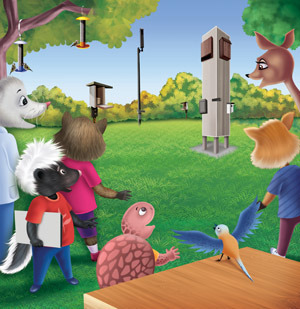
www.progressiverisingphoenix.com
Author Facebook Page
Rachel and Sammy TinyTap Games
Twitter: @JCPowelson
Jannifer Powelson Bibliography:
When Nature Calls – A Nature Station Mystery
Rachel and Sammy Visit the Prairie
Rachel and Sammy Visit the Forest
Rachel and Sammy Learn About Trees
Rachel and Sammy Learn to Conserve

December 18, 2014
The Making of The Lost Castle Treasure Part 3
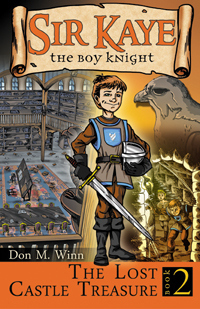 It’s been two years (!) since The Knighting of Sir Kaye, the first book in the Sir Kaye series, was released. In that time there have been abundant inquiries from Sir Kaye fans, young and old, asking when they can expect the second Sir Kaye book. There have been a lot of questions about the Sir Kaye series as well. Today I’m sharing the most frequently asked questions that are uppermost on the minds of our fans. And below is a link to a sneak peek of The Lost Castle Treasure!
It’s been two years (!) since The Knighting of Sir Kaye, the first book in the Sir Kaye series, was released. In that time there have been abundant inquiries from Sir Kaye fans, young and old, asking when they can expect the second Sir Kaye book. There have been a lot of questions about the Sir Kaye series as well. Today I’m sharing the most frequently asked questions that are uppermost on the minds of our fans. And below is a link to a sneak peek of The Lost Castle Treasure!
Why is the second book taking so much longer to write than the first?
For most writers, the second book in a series is often the hardest one to do. A first book sets the foundation of the story and begins to establish the main characters. In a second book of a series (also known as the sophomore book), the writer has to dig deeper into character development.
Writing good characters involves showing parts of the character that may not��seem to be as��lovable. Just like real people, literary characters have good days and bad, good moments and bad. Usually the first book in a series creates a situation of optimal bonding with the characters, but in subsequent books, we look more deeply into the personal struggles of the characters and get to see them in some of their less shining moments.
 I feel that it���s especially important for books to show young readers that humans are not perfect, and that failure or the risk of failure is a part of life for all of us. The excessive glorification in our culture of superheroes with super powers gives the average youngster little in the way of reality to ground him or her in that truth. What about the rest of us, who have no such super powers? How are we supposed to manage? We try, we fail, we try again, we get better, and we keep trying, striving for our best. We all face discouragement and low points during such times of failure. But watching beloved characters deal with these matters provides great learning moments for our readers. Without giving too much away, I will say that all goes well in the end.
I feel that it���s especially important for books to show young readers that humans are not perfect, and that failure or the risk of failure is a part of life for all of us. The excessive glorification in our culture of superheroes with super powers gives the average youngster little in the way of reality to ground him or her in that truth. What about the rest of us, who have no such super powers? How are we supposed to manage? We try, we fail, we try again, we get better, and we keep trying, striving for our best. We all face discouragement and low points during such times of failure. But watching beloved characters deal with these matters provides great learning moments for our readers. Without giving too much away, I will say that all goes well in the end.
Another reason why writing a series can take some extra time is because of the size of the story arc. Plot lines, sub-plot lines, and contingencies all have to be accounted for from the beginning of the series. That way the details in each book are harmonious throughout the series. It’s like writing six books at once. A big job, to say the least.
What can we expect in book two?
In the first book, The Knighting of Sir Kaye, twelve-year-old Kaye Balfour is knighted for doing a brave deed���saving the life of the queen’s nephew. It ends on a rather halcyon note. But in book 2, The Lost Castle Treasure, we get to see a 12-year-old boy dealing with the adult responsibilities of being a knight. We also see that the animosity between the other knights and Kaye is far from over. This presents great challenges to him and his friends. Kaye���s best friend Reggie also faces a number of his own vulnerable moments, several of which will be easy for struggling readers to identify with. Then there is the inkling of a plot against the queen herself!
Will there be any surprises in this book?
There are many moments in the book full of mystery, intrigue, drama, and surprise. Plenty of adventure and fun are on hand as well. Some scenes are powerfully rich in emotional pay-off. Without too many spoilers, the ending is especially satisfying. It touches on our universal human need for parental approval and validation.
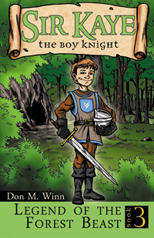 Is book 3 in the works?
Is book 3 in the works?
Yes, it���s under development. For now, illustrator Dave Allred has prepped the cover art and I���ve posted a brief description of the book on my website. Here���s what I know so far about book three: Kaye and Reggie have a big adventure in store for them as they solve another mystery in the Kingdom of Knox. The boys’ tutor is missing! Kaye, Reggie, and Beau set out to find him. Vanishing sheep, rumors of a mysterious beast, and one very determined young girl make this an experience of a lifetime.
And as promised, here���s the link to the sneak peek of Sir Kaye Book 2: The Lost Castle Treasure
Here’s a link to where you can find out more about the Sir Kaye series by Don M. Winn, including Sir Kaye Book 1: The Knighting of Sir Kaye, and information on where you can purchase the books.

December 4, 2014
The Making of The Lost Castle Treasure Part II
When I was a child, the pictures and illustrations were my favorite part of any book. The more pictures the book had, the more I liked the book. Because I was dyslexic, pictures were often the key that made it possible for me to fully understand the story.
In my latest book, The Lost Castle Treasure, book 2 in the Sir Kaye series, there are two illustrations that I���d like to share with you. They both involve a medieval library, lots of illustrated books, and a young dyslexic boy named Reggie that loved every one of them.
The story begins as recently-knighted 12-year-old Sir Kaye Balfour and his best friend Reggie journey to the castle as guests of the queen and her nephew, Beau. For Kaye, this is an opportunity to prove himself to be a worthy knight like his father, Sir Henry. For Reggie, it���s not only the adventure of a lifetime, but best of all, it���s a chance to get away from the lone lineup of expensive tutors that his wealthy wool-merchant father insists on providing for him���or so Reggie thinks.
Reggie doesn���t enjoy any of his tutors. None of them ever stay very long since Reggie seems unable to learn. After all, in medieval times no one knew anything about dyslexia���tutors and Reggie were like oil and water. But Reggie was definitely in for an extraordinary adventure which, to his chagrin, would also include a new tutor.
 The first illustration I want to share today is of the grand library at the castle. This color illustration is featured on the cover of The Lost Castle Treasure. In medieval times, books were rare, and outside of monasteries, whole libraries were even more rare. Many books cost more than the average person earned in years. This particular library was one-of-a-kind. The former king of Knox had loved books. Over the years he collected a tremendous number of them, but by the time he died, the library had fallen into disrepair and books were scattered about. Even so, you can see what a grand library it was. Reggie had never actually seen a library. Just imagine, as you read Reggie���s description of his first glimpse of the library how you would react seeing such wealth and beauty for the first time.
The first illustration I want to share today is of the grand library at the castle. This color illustration is featured on the cover of The Lost Castle Treasure. In medieval times, books were rare, and outside of monasteries, whole libraries were even more rare. Many books cost more than the average person earned in years. This particular library was one-of-a-kind. The former king of Knox had loved books. Over the years he collected a tremendous number of them, but by the time he died, the library had fallen into disrepair and books were scattered about. Even so, you can see what a grand library it was. Reggie had never actually seen a library. Just imagine, as you read Reggie���s description of his first glimpse of the library how you would react seeing such wealth and beauty for the first time.
Excerpt from The Lost Castle Treasure:
���I heaved the door open. It made a horrible screech that echoed all the way down the hall while my heart turned over like a cartwheel in my chest. Stepping cautiously inside, I passed under the watchful gaze of a large wooden falcon perched over the door. I tiptoed a little further into the room, lifted my candle high in the air, and turned in a big circle. I had found the library!
Bookshelves lined all the walls. A balcony ran along all four sides of the room. Stairs led up to this balcony, and there were more bookshelves up there, draped with thick cobwebs, each one trapping years��� worth of dust. Some of the shelves had collapsed, leaving books scattered everywhere.���
This brings us to a scene in the book that is near and dear to my heart. This is after Reggie returns to the library to check it out in more detail. I imagine that his response to all the beautiful handmade and illustrated books would probably be the same as mine would be. In this scene Reggie is sitting amidst a big pile of books carefully reviewing each one, admiring the wonderful craftsmanship and artwork.
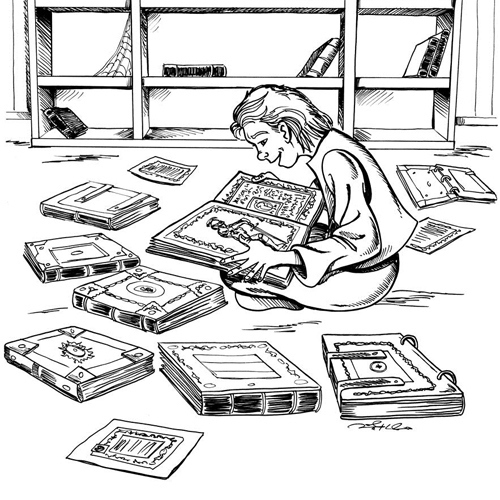
Reggie in the castle library. Illustration by Dave Allred.
Another excerpt from The Lost Castle Treasure:
���Digging through the piles of books, I found a small book with gold covers set with blue and green gems. It was too pretty to read, so I didn���t bother trying. Instead I hid it behind one of the bookshelves. Then I found a real treasure, a book full of stories about Sir Gregory, the most famous knight in the history of Knox. It had big pictures of him slaying a dragon and climbing a tower and doing other knightly things. I hid it in my secret spot so I could try reading it later.���

Medieval Book
As you can see from this picture of an actual medieval book, these books were each carefully hand-crafted and beautifully illustrated. Since they were handmade, no two books were alike.
I hope you enjoyed this preview of illustrations from The Lost Castle Treasure. The book has a total of 16 illustrations throughout to enhance the reader’s experience. I’m so grateful for the meticulous work of illustrator Dave Allred. Thanks, Dave! In Part 3 of The Making of The Lost Castle Treasure we���ll give you a sneak peak at the book.

November 20, 2014
The Gift of Your Time
As autumn’s quiet contemplation ushers in the busy winter season, many people have gift giving on their minds. It’s an interesting time of year���it can be positive and restful, as the earth begins her season of stillness and recharges for next spring’s growth. Or it can be hectic, even chaotic. Most of us are familiar with having lots of obligations, both personal and professional. When that sense of obligation intrudes into gift giving, it tends to take the shine off the experience. However, when gift giving is not tarnished by a sense of obligation, it can bring genuine pleasure, not just to the recipient, but even more so to the one giving. I would guess that every parent or grandparent can attest to the joy they personally feel when they see the eyes of their child or grandchild light up with excitement when presented with a gift.
I certainly loved getting gifts when I was a kid. Although I had a few favorite toys, there was no toy that gave me greater pleasure than when my mom, dad, or grandmother would spend time with me. Some of my favorite childhood memories involve spending the night at my grandmother’s when she would devote about an hour before bedtime reading with me and asking me questions from a children���s dictionary. I loved that! Not so much the children���s dictionary���rather it was having that one-on-one time with my grandmother.
Lesson: The gift of our time is the greatest gift of all.
 All CBA picture books are designed for parents, grandparents, relatives, teachers, caregivers, and friends to read aloud with children. When you give a CBA book to a child, you are also giving them some of yourself as you take the time to read the books aloud together and talk about what you���ve read. Your child, niece, nephew, grandchild, or student will long appreciate and remember the time you spend with them.
All CBA picture books are designed for parents, grandparents, relatives, teachers, caregivers, and friends to read aloud with children. When you give a CBA book to a child, you are also giving them some of yourself as you take the time to read the books aloud together and talk about what you���ve read. Your child, niece, nephew, grandchild, or student will long appreciate and remember the time you spend with them.
Each book has a fun teaching theme that parents can use to illustrate important life lessons as well as questions for discussion. For a list of topics contained in each CBA book check out the Lesson Reference Guide.
The hardcover picture books have additional creativity questions at the end that can be used to help kids to use their imaginations and ���think outside the book.���
 The Sir Kaye the Boy Knight�� chapter books follow the adventures of young Kaye Balfour and his best friends. This warmhearted, humorous adventure series shows how a twelve-year-old in the medieval land of Knox is knighted, becomes the most famous knight in the country, and has adventures as he strives to be a loyal and true knight.
The Sir Kaye the Boy Knight�� chapter books follow the adventures of young Kaye Balfour and his best friends. This warmhearted, humorous adventure series shows how a twelve-year-old in the medieval land of Knox is knighted, becomes the most famous knight in the country, and has adventures as he strives to be a loyal and true knight.
Begin the adventure with the first book in the series, The Knighting of Sir Kaye and then follow up with the soon to be released second book in the series, The Lost Castle Treasure. Read a sneak peek of The Knighting of Sir Kaye here.
 Here���s what some fans have said about CBA books:
Here���s what some fans have said about CBA books:
From a parent about The Knighting of Sir Kaye audio book: ���We sat and listened together on the edge of our seats! They absolutely loved it, as did I, and they’ve already started listening to it again! I LOVED, LOVED, LOVED the fact that this was a fun (and wholesome) story that was TOTALLY age appropriate for my 9-year-old son, but was still completely enjoyed by my 8-year-old daughter as well!���
From a parent who was a guest reader in her daughter���s classroom: ���I have been guest reader many times and students always want to converse after the story is over. Having the questions at the end created a richer educational dialogue that I enjoyed most.���
From a grandfather who read The Tortoise and the Hairpiece with his grandson: ���I was amused at the rhyming as was [my grandson]. The new word, regale, caused us to discuss the meaning. The art work is excellent. I received a studio art degree many years ago and recognize your illustrations as first rate.���
From a grandparent: ���I discussed [the questions] with my granddaughter and they gave her a great opportunity to practice both listening skills (she���s learning to read) and recall of detail.���
My picture books and Sir Kaye the Boy Knight chapter books series for middle readers make great gifts and are available as softcovers, hardcovers, and eBooks from Amazon, Barnes and Noble, and the iTunes store, as well as your other favorite online retailers.
All Cardboard Box Adventures picture books have been named among the best in family-friendly media, products and services by the Mom���s Choice Awards��


November 13, 2014
My Child Is So Bright! Why Can���t He Read?
Parents of toddlers and preschoolers are often astonished at the things their kids can do. Their brains are truly like sponges, soaking up their environment, and then mimicking the behaviors around them. The human brain is at its most plastic from birth to 5 years, and the quantum leaps in learning that children demonstrate during this period are humbling to behold.
However, as many as 1 in 5 kids have a very different experience when they enter school. When introduced to the written word, it may seem as if their brain has suddenly developed a charley-horse, cramped and frozen rather than flexible and malleable.
Thus begins the paradoxical life of dyslexics. They may be bright, even brilliant, at some forms of learning and problem solving, yet unable to read well. Reading is a work-intensive and often��exhausting process for them.
Concerned parents can be stymied by this disparity���how can the child who has always seemed so bright and intuitive possibly be having this much trouble to learn to read? Their intelligence is indisputable, so where’s the disconnect?
For answers, we turn to the Yale center for Dyslexia and Creativity. Sally E. Shaywitz, M.D., co-director of the program, helps us understand how this can occur.
Non-dyslexic readers can and do learn to associate letters with specific sounds, thereby developing the ability to sound out words. Once learned, this process becomes effortless. “All they have to do is look at the letters and it’s automatic,” Shaywitz explains. “It’s like breathing; you don’t have to tell your lungs to take in air. In dyslexia, this process remains manual.”
And here’s the disparity: in typical readers IQ and reading ability not only remain on parallel tracks, but influence each other over time. As the one grows, so does the other. But in people with dyslexia, IQ and reading are not linked and do not influence each other.
This discrepancy between reading and IQ was found��after a��study called the Connecticut Longitudinal Study, where students were tested during all 12 years of their time in school.
Graphic Credit: Sally and Bennett Shaywitz, Yale University, Psychological Science
“I’ve seen so many children who are struggling to read but have a high IQ,” said Shaywitz. “Our findings of an uncoupling between IQ and reading, and the influence of this uncoupling on the developmental trajectory of reading, provide evidence to support the concept that dyslexia is an unexpected difficulty with reading in children who otherwise have the intelligence to learn to read.”
“A key characteristic of dyslexia is that the unexpected difficulty refers to a disparity within the person rather than, for example, a relative weakness compared to the general population,” said co-author Bennett A. Shaywitz, M.D., the Charles and Helen Schwab Professor in Dyslexia and Learning Development and co-director of the Yale Center for Dyslexia and Creativity.
Imagine seeing every word, each time you attempt to read, as if you’ve never seen the word before. Those of us with dyslexia have to read slowly, re-read, and use colored markers so we don’t lose our place. We take longer to retrieve words when reading and sometimes even when speaking, and can seem less fluid at these tasks than our peers. The pop-quiz/standardized testing environment only contributes to a student’s anxiety, and can worsen the difficulties.
Take-away thought: If your child is dyslexic, they have a language-processing problem, not an intelligence problem. And that is a very different distinction that requires a very different plan of action.
For more information, please see some of my earlier blogs on dyslexia:
Understanding Your Dyslexic Friend/Child/Spouse/Student
Dyslexia Presentation: A Few Facts From The Big Picture Documentary
Alleviating the Complications of Shame for Dyslexic Children
Tools and Strategies for Dealing with Dyslexia: Reading Aloud
Creative Writing and Dyslexia: A Worthwhile Challenge
Everyone Fails at First


My Child Is So Bright! Why Can’t He Read?
Parents of toddlers and preschoolers are often astonished at the things their kids can do. Their brains are truly like sponges, soaking up their environment, and then mimicking the behaviors around them. The human brain is at its most plastic from birth to 5 years, and the quantum leaps in learning that children demonstrate during this period are humbling to behold.
However, as many as 1 in 5 kids have a very different experience when they enter school. When introduced to the written word, it may seem as if their brain has suddenly developed a charley-horse, cramped and frozen rather than flexible and malleable.
Thus begins the paradoxical life of dyslexics. They may be bright, even brilliant, at some forms of learning and problem solving, yet unable to read well. Reading is a work-intensive and often exhausting process for them.
Concerned parents can be stymied by this disparity—how can the child who has always seemed so bright and intuitive possibly be having this much trouble to learn to read? Their intelligence is indisputable, so where’s the disconnect?
For answers, we turn to the Yale center for Dyslexia and Creativity. Sally E. Shaywitz, M.D., co-director of the program, helps us understand how this can occur.
Non-dyslexic readers can and do learn to associate letters with specific sounds, thereby developing the ability to sound out words. Once learned, this process becomes effortless. “All they have to do is look at the letters and it’s automatic,” Shaywitz explains. “It’s like breathing; you don’t have to tell your lungs to take in air. In dyslexia, this process remains manual.”
And here’s the disparity: in typical readers IQ and reading ability not only remain on parallel tracks, but influence each other over time. As the one grows, so does the other. But in people with dyslexia, IQ and reading are not linked and do not influence each other.
This discrepancy between reading and IQ was found after a study called the Connecticut Longitudinal Study, where students were tested during all 12 years of their time in school.
Graphic Credit: Sally and Bennett Shaywitz, Yale University, Psychological Science
“I’ve seen so many children who are struggling to read but have a high IQ,” said Shaywitz. “Our findings of an uncoupling between IQ and reading, and the influence of this uncoupling on the developmental trajectory of reading, provide evidence to support the concept that dyslexia is an unexpected difficulty with reading in children who otherwise have the intelligence to learn to read.”
“A key characteristic of dyslexia is that the unexpected difficulty refers to a disparity within the person rather than, for example, a relative weakness compared to the general population,” said co-author Bennett A. Shaywitz, M.D., the Charles and Helen Schwab Professor in Dyslexia and Learning Development and co-director of the Yale Center for Dyslexia and Creativity.
Imagine seeing every word, each time you attempt to read, as if you’ve never seen the word before. Those of us with dyslexia have to read slowly, re-read, and use colored markers so we don’t lose our place. We take longer to retrieve words when reading and sometimes even when speaking, and can seem less fluid at these tasks than our peers. The pop-quiz/standardized testing environment only contributes to a student’s anxiety, and can worsen the difficulties.
Take-away thought: If your child is dyslexic, they have a language-processing problem, not an intelligence problem. And that is a very different distinction that requires a very different plan of action.
For more information, please see some of my earlier blogs on dyslexia:
Understanding Your Dyslexic Friend/Child/Spouse/Student
Dyslexia Presentation: A Few Facts From The Big Picture Documentary
Alleviating the Complications of Shame for Dyslexic Children
Tools and Strategies for Dealing with Dyslexia: Reading Aloud
Creative Writing and Dyslexia: A Worthwhile Challenge
Everyone Fails at First


November 6, 2014
The Making of The Lost Castle Treasure Part 1
 Two years in the making, my second middle-grade children’s novel, Sir Kaye the Boy Knight Book 2: The Lost Castle Treasure, is now being prepped for release. In an upcoming blog I’ll provide a special sneak peek of the book but first I’d like to take the opportunity to thank everyone who assisted me with my medieval research. In addition to striving for fun books, I want my books to be fairly accurate and instructive as well. Since the books are set in a fictional medieval country, they may not be 100% historically accurate, but I did strive to create an authentic medieval atmosphere, and I couldn’t have done it alone. If you’ve missed any of my posts on background research, don’t worry— all the links are consolidated below. Enjoy!
Two years in the making, my second middle-grade children’s novel, Sir Kaye the Boy Knight Book 2: The Lost Castle Treasure, is now being prepped for release. In an upcoming blog I’ll provide a special sneak peek of the book but first I’d like to take the opportunity to thank everyone who assisted me with my medieval research. In addition to striving for fun books, I want my books to be fairly accurate and instructive as well. Since the books are set in a fictional medieval country, they may not be 100% historically accurate, but I did strive to create an authentic medieval atmosphere, and I couldn’t have done it alone. If you’ve missed any of my posts on background research, don’t worry— all the links are consolidated below. Enjoy!
Transportation in Medieval Times
Special thanks go to Alex Cord for his generous support of the first Sir Kaye book, The Knighting of Sir Kaye, and to Susannah Cord for her insightful answers to questions about horse and human interaction. Thanks Alex and Susannah!
Medieval Horses
Susannah Cord on Horse and Human Interaction
Falconry in Medieval Times
Out of all my research topics the one I enjoyed the most was when I was able to get away from my desk to have an actual semi-medieval experience. That opportunity was afforded to me when I spent a day with Texas Falconer Lynne Holder and her Harris Hawk, Dart. It was a wonderful adventure and we got lots of great pictures. If you haven’t checked out the falconry blogs here are the links. Thanks Lynne for a fantastic day!
Falconry Part 1—Medieval and Modern Falconry
Falconry Part 2—My Day with Dart
Falconry Part 3—Interview with Lynne Holder, Texas Falconer
Storytelling in Medieval Times
The nature of stories and storytelling has changed over the years, and I’d like to thank Garrison Martt for sharing his insights on stories, storytelling, and libraries in medieval times. Thanks Garrison!
Saturday Morning Cartoons and Generations of Story Lovers
Medieval Storytelling: The Spoken Word
Medieval Storytelling: Books and Libraries
Castles in Medieval Times
Medieval research would not be complete without exploring medieval castles. In fact, the castle is one of the main characters in The Lost Castle Treasure. I’d like to thank Bob Lawson, the Curator of the Ferniehirst Castle in Scotland, for his encouraging support of the first Sir Kaye book and for answering all my castle questions for me. Thanks Bob!
Medieval Castles Part 1: Protection From Marauders
Medieval Castles—Interview with Bob Lawson, Curator of Ferniehirst Castle in Scotland
Food in Medieval Times
Although most of my medieval food research came from resource material, I have to posthumously thank my grandfather and both my parents for the culinary heritage that gave me the confidence to delve into my own medieval cookery experiment. My family foodie history stood me in good stead here.
Writing, Food, and Family History
Medieval Food Facts for Kids
Medieval Cookery Experiment
Music in Medieval Times
I can’t even begin to imagine a generation that didn’t create music of some sort, and music is certainly a feature in The Lost Castle Treasure. I’d like to thank musician, lutenist, and medieval music enthusiast Ron Braley for helping me out on this score and answering all my music-related questions. Thanks Ron!
Lute Music During the Middle Ages—Interview with Ron Braley
Medicine in Medieval Times
When active kids meet the outdoors, there’s a need for first aid in any generation. I’d like to thank acupuncturist and medieval history buff Kathy Kerr for helping research medicine and first aid in medieval times. Kaye and Reggie are most appreciative too. Thanks Kathy!
Medieval Medicine and First Aid
And finally, although we didn’t do an official interview or post a blog on this topic, a big thanks goes to Dr. David Ciambrone for his helpful information about medieval poisons and poisoning techniques. To learn why I sought his guidance, you’ll have to read the The Lost Castle Treasure!
I hope you’ve enjoyed these medieval research blogs. Part 2 of The Making of The Lost Castle Treasure will give you a preview and a little medieval history as it relates to the terrific Lost Castle Treasure illustrations by artist Dave Allred. Part 3 will offer a sneak peak at the book that you won’t want to miss.


October 30, 2014
Highly Sensitive Parent Survival Tips from Megan Tietz
Who hasn’t felt overwhelmed from time to time when dealing with a house full of kids? It can be rough on anyone, but for the Highly Sensitive Person, it can become a daily struggle.
I recently came across this blog by Megan Tietz, where she shares her personal account of a mom on sensory overload, and how she copes: http://www.sortacrunchy.net/sortacrunchy/2014/06/survival-guide-for-the-highly-sensitive-parent-.html
I thought this was worth sharing.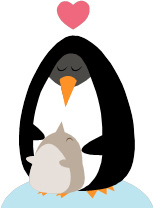
Elsewhere, advice for overwhelmed parents may include tips such as “avoid chaotic environments and get plenty of rest.” Not likely in homes with young children! Instead, Megan’s list of survival tips are actually do-able.
Takeaway: the more parents can be calm and action-oriented (as opposed to reactive), the more effective and loving parenting becomes. And isn’t that what matters?






